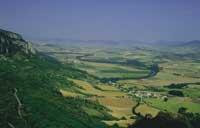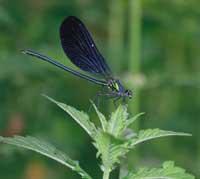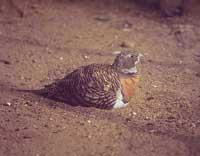News: June
Kri-kri-kri-kri-kri-kri… Neither trikitixa, nor rokanrol, nor “cod”. This is the music most heard in Euskal Herria in the sanjuanes. The performances of the Kilkir are also free and to listen to them it is enough to approach a field of grass and pay attention.

At this time when we are enjoying the longest days of the year, most animals are working massively: kilkirrak in its eagerness to attract reproductive singers, many other offspring, etc. The increase in temperatures is accompanied by a large number of crickets and other insects and invertebrates. In addition to beautiful butterfly bugs, txitxiburduntzi, ladybug and the like, anywhere you can find ticks, command flies or mosquitoes that we do not like so much. However, these invertebrates feed a large number of animals, all of them of great importance in the ecological pyramid.
Spring has also reached the Pyrenean helmets and has been filled with beautiful flowers. Finally, local pastors will also be able to ascend to higher pastures. As for the south, the wheat fields have begun to yellow and the cherry trees are full of fruits. In the streets, at the gates of summer, it's time to start preparing trousers, skirt and short shirts.
Prank metamorphosis
The behavior of the larvae of the txitxiburduntzis in the village regatta is surprising in recent days. And, although they eat normally, lately they have no snack and you can see that something is about to happen. Suddenly, one of them emerges and gradually ascends into a reed. It seems that oxygen has begun to breathe!

Look at the reader, that our water larva prepares to disembark! When he is in the reed, a crack has been made in the back and a whitish body has begun to appear (in the most expensive movies of the aliens no scenes of this type are seen either! ). It took a couple more hours to dismantle this old deck and open two pairs of fins. Hours earlier, the water larva has become a colorful prank that flies along the river. Goodbye!
Snake on the verge
For the misfortune of snakes, with a warm environment it is usually not difficult to find a snake. In Mediterranean Ixurialde, for example, it is easy to see the snake of Montpellier. This fast snake is poisonous, but its canines are inside the mouth and it is almost impossible for a person to introduce poison. However, even if you get this poison is not very effective for the human being. But to dominate mice and other small animals that hunt reptiles is great. So, as soon as you reach a little mouse and start swallowing, with these tusks from the back of the mouth, puts poison to facilitate belly and digestion tasks.
Changing costumes

Although they are usually not very colorful, occasionally snakes are seen with little color. This feature indicates that the skin is about to change and stops eating snakes. Gradually, under the old develops the new and when the leather is about to change takes a bluish color. At a given moment he opens the gap around his lips and with this swollen hole he pulls out his head. Thanks to the movements of the snake, just as a glove is removed from the hand, it undo the aged leather and having a new way of dressing below, we are presented with a snake of vivid colors.
The process seen, the renewal of the leather, that is, the snakes do it 5-6 times a year. Amphibians also alter the skin, the same happens with the outer cover of invertebrates. Something similar happens to humans after burning in the sun.
Bird Hill
Just as snakes restore the skin, bird feathers also age and, of course, they must also be modified. When all the feathers fall at once, they would lose their ability to fly, so they change them gradually and in a certain order.
However, many species of duck, when they do, stay a few days unable to fly, so they should go to the appropriate wetlands. The change of feathers has a great energy need and, of course, birds do it in the time that suits them best. Many renew it after breeding and thus, by the time of migration, have ready the new plumage.
Amiltxoris in Las Cañas

Amiltxoris are nocturnal birds of the heron family, despite being relatively small compared to them. They inhabit wetlands and adapt perfectly to dense vegetation. As soon as it gets dark, birds have time to eat and are the animals that hunt the most, aquatic insects, crustaceans and small vertebrates. After spending the winter in Africa, they return in April to reproduce. In Euskal Herria we have famous colonies of birds.
In Lapurdi, for example, there is a beautiful colony on the islands of the Aturri River facing Lehuntze, Urketa and Ahurti. In Navarra it is grown in forests located on the banks of the Ebro and Aragon rivers and especially in the lagoon of “Las Cañas” of Viana. In addition, Navarra has more than 325 couples.
Vaults south of Navarre

These are vaults, steppes and birds of dry areas that live mainly in the Basque Country, the Bardenas and nearby plains. They have the size of the pigeons and are perfectly adapted to live in these dry and warm regions. Two species of vaults inhabit our territory: the ribbed vault and the sirloin. Both are very scarce and although there may be about 800 specimens of the first, it is estimated that the population of the Navarra cross-vaults ranges between 400 and 700 specimens, so it is very small.
These birds, having to drink water almost every day, frequently resort to wells and rivers. The milestones also need water and the vaults take them in a very special way during breeding. Parents when they drink put their chest in the water to collect a few drops of water in the pen. Then at a glance the chitons are given to grab them.
Hare, as discreet as suspicious
Today, looking for the first lettuce of the year, we have met a child on foot. Fairy and sinkhole, when no mother appears, we have been tempted to take the crazy to the house. However, in the end we decided to leave him there and thank you, because his mother was not going to be far.

The hare is a prudent animal. After delivery and during the month of breastfeeding, the mother often distributes the offspring. Everyone hides in a certain place and he will give milk one by one. This behavior may increase the risk that enemies will find a breeding, but it also increases the chance that a child will get ahead.
In addition to babies, at this time you can find offspring of many other species: chorizos, deer... but look! Although they seem lost and unprotected, most of the time the mother is not usually far away. However, if we take it by hand, it can frighten your mother and not dare to take care of your children. Also, if we get the young to take home and grow, releasing them would hardly adapt to their way. So think twice before a child comes home.





